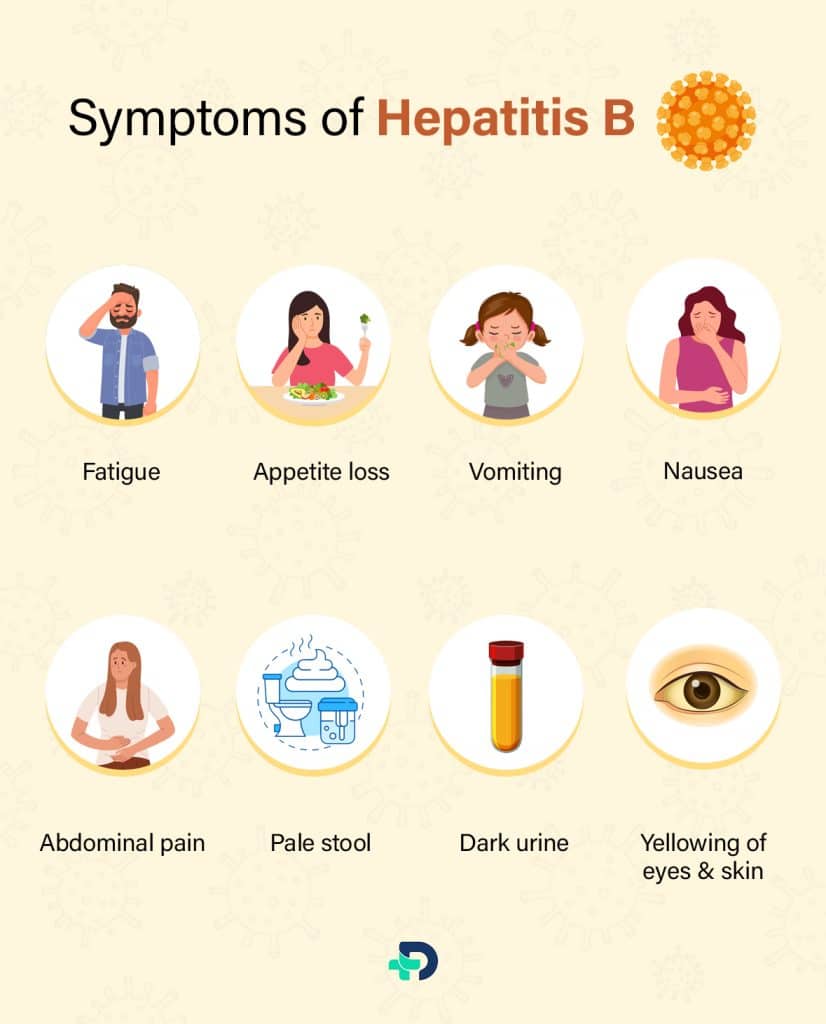Hepatitis B: Causes, Symptoms, and Treatment

- Hepatitis B
- 17 Aug 2023
Overview
What is Hepatitis B?
A viral infection called hepatitis B that damages the liver can result in chronic and acute infections. It is brought on by the virus known as hepatitis B (HBV), which can be spread by getting into touch with an infected person’s blood or other bodily fluids. With millions of cases worldwide, hepatitis B is a severe health issue. Most people only experience an acute, temporary infection. However, it develops into a long-term infection for certain people. This article will discuss the causes of hepatitis B, how it is spread, its symptoms, risk factors, diagnosis, prevention, complications, and prognosis.

Types
Types of Hepatitis B
Hepatitis B infection can be of two types, namely
- Acute type
- Chronic type
Acute hepatitis B
- Occurs within the first six months of a person being exposed to the hepatitis B virus and is a temporary infection1Types| Researched based study from Cdc.gov
Chronic hepatitis B
- If the virus stays in the body for more than six months and eventually results in significant health issues.
Symptoms

Symptoms of Hepatitis B
Some individuals, particularly small kids, do not display any symptoms. However, other infected individuals may exhibit the following symptoms:
- Fatigue
- Appetite loss
- Vomiting
- Nausea
- Abdominal pain
- Pale stool
- Dark urine
- Yellowing of eyes and skin 2Symptoms| Researched based study from Who.int
Causes
Hepatitis B causes & transmission
- It is caused by the hepatitis B virus (HBV) which belongs to the family Hepadnaviridae.
- The virus is extremely contagious and has a seven-day survival time outside the body.
How is hepatitis B transmitted?
The following methods are used to spread hepatitis B from one person to another:
- Direct exposure to contaminated blood
- Sexual activity
- From a mother who is infected to her child
Contact with Infected Blood
It is the most typical method of spread and is through contact with blood that is infected and may include :
- Using contaminated or non-sterile medical, dental, or cosmetic needles or equipment.
- The sharing of needles by illicit IV drug users3Causes| Researched based study from Hepb.org
- During medical operations such as organ transplants or blood transfusions.
- Using non-sterile needles when getting acupuncture, tattooed, or pierced.
Sexual activity
- HBV can be spread through unprotected sex with an infected individual.
- The virus can be detected in an infected person’s vaginal secretion or semen.
Mother to child transmission
- During childbirth, an infected mother’s newborn can contract HBV.
- However, with good prenatal care, immunization, and giving of hepatitis B immunoglobulin to the infant, the risk of transmission can be considerably decreased.
Risk
People at high risk
Although anyone could develop hepatitis B at any moment in their lives, the following individuals are more vulnerable :
- People born in regions with a high prevalence of hepatitis B, such as Eastern Europe, South America, Africa, Asia, and the Pacific Islands.
- Workers in health care or laboratory who are in danger of being exposed to blood or contaminated body fluids.
- Those who have unprotected intercourse.
- Individuals who engage in sexual activity with more than one partner.
- Same-sex partners who are guys.
- Those identified as having any other Sexually transmitted infections (STIs).
- People who have previously used illegal drugs.
- Patients on dialysis and those with early kidney failure.
- All pregnant women and all children born to pregnant infected women.
- A person who has infected sexual partners.
- Kids adopted from nations where hepatitis B is widespread.
- People on immunosuppressive drugs.
- Travelers to nations where the frequency of the Hepatitis B virus is intermediate or high. 4Risk| Researched based study from Nlm.nih.gov
Diagnosis
Diagnosis of Hepatitis B
Healthcare professionals use a complete medical history, physical examination, and the following tests to diagnose hepatitis B infection:
- Blood Tests – detect the presence of hepatitis B antigens and antibodies in the blood, indicating past or current infection.
- Liver Function Tests – determine the number of proteins and enzymes secreted by the liver to determine the health of the liver.
- Liver ultrasound – helps to analyze the severity of liver damage.
- Liver biopsy – To check for liver injury, the doctor may take a small sample of the injured liver for testing.5Diagnosis| Researched based study from Mayoclinic.org
Prompt and accurate diagnosis of hepatitis B is crucial for effective management.
Treatment
Treatment of Hepatitis B
Treatment of Hepatitis B may include
Post exposure prophylaxis
- Immunoglobulin, an antibody administered intravenously within 24 hours after virus exposure, may aid in preventing hepatitis B infection6Treatment| Researched based study from clevelandclinic.org
- This should be followed by hepatitis B vaccine in individuals who have never had it because this treatment only offers temporary protection.
Managing Acute hepatitis B
- Many people with acute hepatitis B infections won’t require any treatment and some exhibiting severe symptoms may require supportive care like pain relief and Iv nutrition.
Managing Chronic Hepatitis B
- Based on the patient’s condition and risk factors, a healthcare professional will advise treatment to convert hepatitis B positive to negative.
Hepatitis B medication may include:
- Immune modulator drugs
- Oral antiviral medications
Immune modulator drugs
- Are replicas of the antibodies that our bodies make to combat illnesses and are also known as interferons
- They may include peginterferon alfa-2a and alfa-2b4Treatment| Researched based study from Nlm.nih.gov
- They are provided as first-line therapies for children and some adults and are injected for a duration of six to twelve months.
Oral antiviral medications
- Are the most effective treatments for reducing HBV.
- Includes entecavir, tenofovir alafenamide, and tenofovir disoproxil.
- The doctor may recommend one or more of these antiviral drugs based on how the person responds.
Surgical management
- Liver resection – The liver may need to be partially or entirely removed during surgery depending on the extent of the damage; as long as enough healthy tissue is left after partial resection; the liver can regenerate.
- Liver transplant – if the liver fails to function or is extensively damaged7Treatment| Researched based study from Ucsf.edu
Lifestyle changes
To improve the effectiveness of treatment and safeguard the liver from additional damage, people can also make some lifestyle modifications by:
- Avoiding alcohol.
- Keeping up a balanced, healthful diet.
- Exercising frequently to maintain a healthy weight.
Complications
Hepatitis B related Complications
Several complications from a hepatitis B infection may include:
- Cirrhosis of the liver – characterized by liver tissue scarring and diminished liver function, can be brought on by persistent inflammation and liver injury.
- Liver cancer – Hepatocellular carcinoma is the most common type of primary liver cancer, strongly associated with chronic hepatitis B infection.
- Liver failure – Rarely, acute hepatitis B can lead to liver failure if the liver suffers severe damage and stops functioning. End-stage liver disease is another name for liver failure8Complications| Researched based study from Niddk.nih.gov
Prevention
Prevention of Hepatitis B
The following measures effectively decrease hepatitis B virus spread :
- Vaccination – The best strategy to prevent hepatitis B in newborns, children, and adults is the hepatitis B vaccine. Depending on the vaccination used, it is given in three or four doses2Prevention| Researched based study from Who.int
- Safe Injection Practices – Healthcare settings should adhere to strict infection control measures, including sterile equipment and safe injection practices to prevent the transmission of HBV.
- Safe Sexual Practices – Limiting the number of sexual partners and using condoms can help reduce the risk of HBV transmission.
- Not Sharing Personal Items – Avoid sharing personal items such as razors, or toothbrushes, which may come into contact with blood or bodily fluids.
- Screening of Blood Donors – Screening all donated blood for HBV ensures that infected blood is not used for transfusions.
- Post-Exposure Prophylaxis – Immediate administration of hepatitis B immunoglobulin (HBIG) and the hepatitis B vaccine after exposure to HBV can help prevent infection.
Prognosis
Prognosis of Hepatitis B
The prognosis of hepatitis B depends on various factors, including the age of infection, the individual’s immune response, and the presence of underlying liver disease. Most people with acute hepatitis B recover completely within a few months with supportive care, rest, and appropriate medical management. The prognosis of chronic hepatitis B varies. Some individuals can achieve long-term viral suppression and have a low risk of liver complications with antiviral medications. However, others may progress to advanced liver disease, requiring close monitoring and potential liver transplantation.
Any feedback on this article?
 This Articles content was accurate
This Articles content was accurate Very Informative Article
Very Informative Article I have a question or a comment
I have a question or a comment
 This article contains inaccurate content
This article contains inaccurate content This article was not helpful
This article was not helpful I have a question or a comment
I have a question or a comment
We appreciate your helpful feedback!
Checkout our social pages
References
-
Centers for Disease Control and Prevention
Viral Hepatitis-Faq's | Types
-
World Health Organization
Hepatitis B | Symptoms
-
Hepatitis B foundation
Transmission of Hepatitis B | Causes
-
National Library of Medicine
Hepatitis B | Risk
-
Mayo clinic
Hepatitis B | Diagnosis
-
Cleveland Clinic
Hepatitis B | Treatment
-
The Regents of the University of California
Hepatitis B | Treatment
-
National Institute of Diabetes and Digestive and Kidney Diseases
Hepatitis B | Complications






































